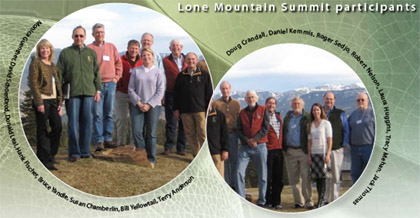As the presidential campaigns wear on, candidates vie to show their differences on issues most important to voters. At the moment, the war in Iraq and the economy occupy the most attention, with health care, terrorism, and immigration grabbing their fair share. Farther down the list is global warming, followed by other environmental issues.
Though environmental issues are not their highest priority, candidates are already finding opportunities to strut their green colors—each hoping to appear a darker shade of green than their opponents.
Whether Democrat or Republican, most candidates go green by advocating stricter controls on carbon emissions, greater energy efficiency to reduce fossil fuel consumption, reduced dependence on Middle Eastern oil, and, in general, more regulations from Washington bureaucracies.
Green strutting aside, however, none of the primary candidates is likely to get down to the nitty-gritty of proposing environmental policies that could actually make a difference in environmental quality and capture the common-sense environmental voter. Only when the field is narrowed to two or three candidates can we expect White House seekers to begin refining their policies on more and more issues, including the environment.
Candidate Bush did this in the 2000 election by appointing a team to advise him on the environment. The team included Gale Norton (later appointed secretary of interior), Lynn Scarlet (later appointed acting secretary of interior), Robert Nelson (an economist with the Department of Interior’s Office of Policy Analysis, spanning administrations from Reagan to Bush), and many others, including myself, familiar with free market environmentalism.
When the team first met with Governor Bush, all were excited about the prospect of actually making real changes in environmental policies. Though some of the proposals diverged significantly from the status quo, for example, allowing grazing permit holders to sell their permits to environmental groups for non-grazing uses, none were so bold as to call for privatization of federal lands or major reform of the Endangered Species Act. Few proposals from this team saw the light of day. It was politics as usual as the Bush White House tried to swing the environmental pendulum back from the perceived environmental extremism of the Clinton administration. Whether the pendulum swung very far in either administration is questionable, but it is clear from both that environmental policy has not been spared from the gridlock that epitomizes Washington.
Believing that there are many environmental policy options that can break the gridlock and go beyond traditional party lines, PERC convened its 2008 Lone Mountain Summit with the aim of “finding ways that work,” to use the motto of Environmental Defense. Summiteers included policy analysts steeped in the traditions of free market environmentalism—Bruce Yandle, Clemson University; Robert Nelson, University of Maryland; and Donald Leal, PERC; policy analysts not so attached to free market environmentalism—Daniel Kemmis, Center for the Rocky Mountain West; and Roger Sedjo, Resources for the Future; former policy makers from democratic administrations—Jack Ward Thomas, Chief of the U.S. Forest Service; and Bill Yellowtail, regional director of the EPA, both under the Clinton administration; policy makers from republican administrations—Tracy Mehan, deputy director of the EPA; and Doug Crandall, U.S. Forest Service, both under the Bush administration; and environmentalists— Hank Fischer, National Wildlife Federation; and David Schoenbrod, formerly with Natural Resources Defense Council and now law professor at New York Law School.
We began our meeting by agreeing on some free market principles to guide non-partisan policies. Among the principles were ideas such as property rights make the environment an asset and therefore encourage stewardship; markets force people to face up to costs of resource use and encourage efficiency; and devolution to more local levels of government encourages conflict resolution and more rational consideration of tradeoffs.
Summiteers had no trouble finding abundant examples of how these principles could be applied. Millions of acres of public lands have become a fiscal and environmental liability when they should be an asset. Water is cheaper than dirt for most users thus encouraging them to treat it accordingly. And because water delivery is subsidized, the private sector has little incentive to make necessary investments in infrastructure. Endangered species are a liability to landowners— private and public—and therefore habitat for those species is underprovided. Devolution to more local groups might encourage more careful consideration of the tradeoffs and better land management for species and commodities.
Using these principles, summiteers quickly found consensus for many policies that ought to be in the platforms of all truly green politicians. The articles in this issue of PERC Reports consider how the principles of free market environmentalism might yield more common-sense environmental policies. The articles are not exhaustive though there is plenty of literature that could provide additional fodder for an entrepreneurial candidate. (For example, see PERC’s latest book, Accounting for Mother Nature: Changing Demands for her Bounty [2008] available from Stanford University Press.)
Regardless of your political color, if you are truly green, you cannot ignore the gridlock that plagues environmental policy or the importance of common sense in giving us a better environment at a much lower cost. The adage that “no one washes a rental car” speaks volumes for environmental reform proposed by candidates claiming to be the harbingers of change. If they are serious about changing environmental policy for the better, then ways must be found to reward people who take care of our natural resources. May common-sense environmental ideas begin to permeate the party platforms and make the environment an asset to be stewarded rather than a liability to be squandered.
In his “On Target” column, PERC’s executive director Tery L. Anderson confronts issues surrounding free market environmentalism.




